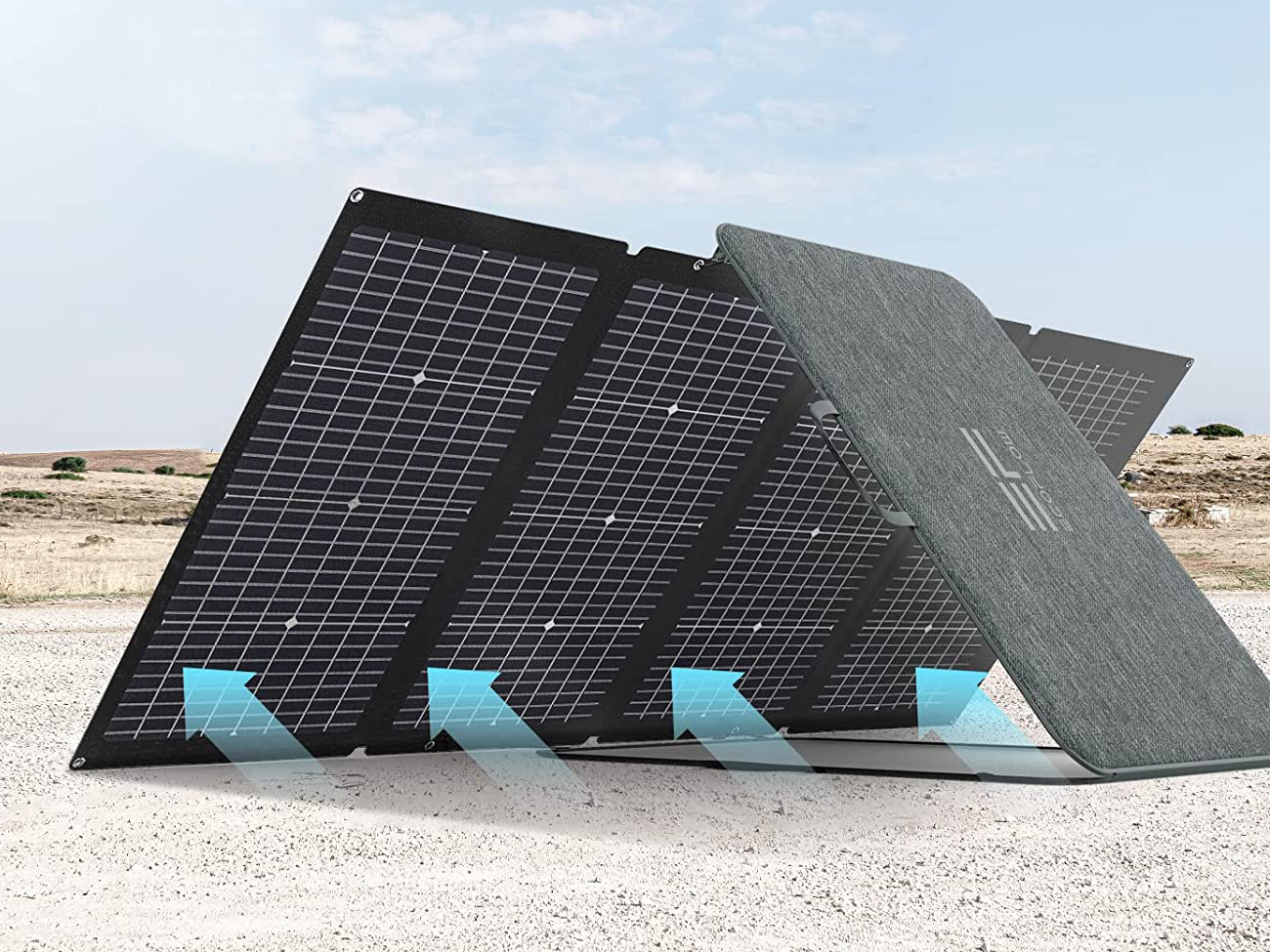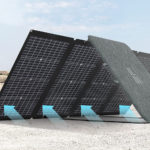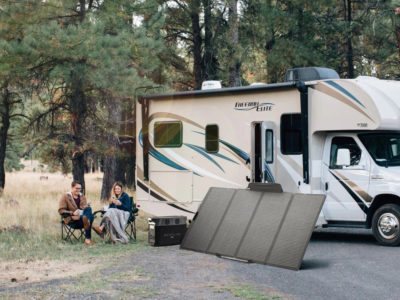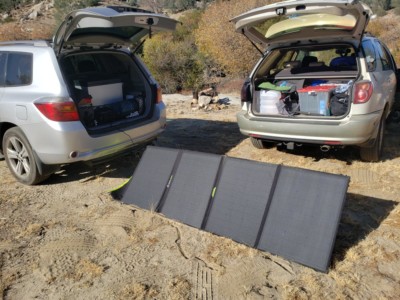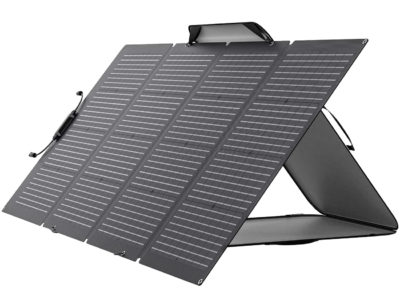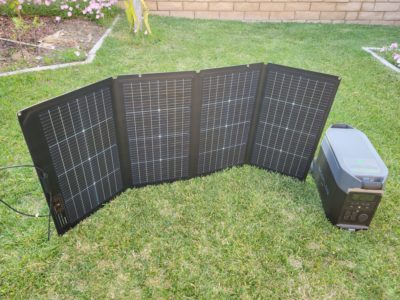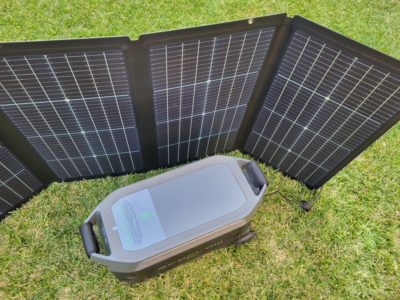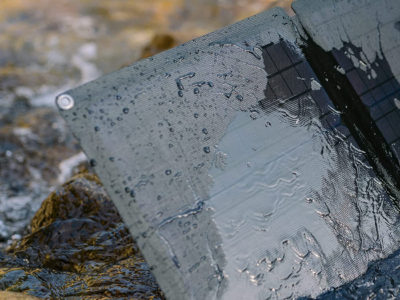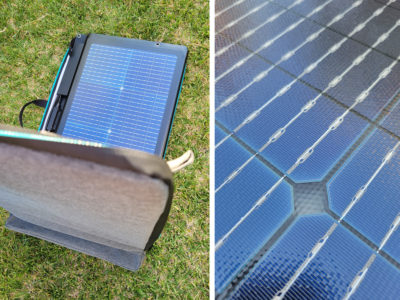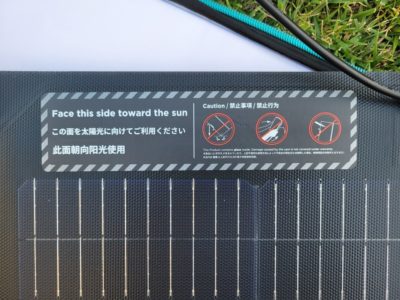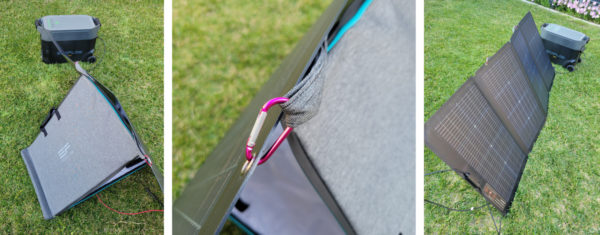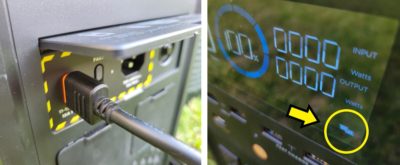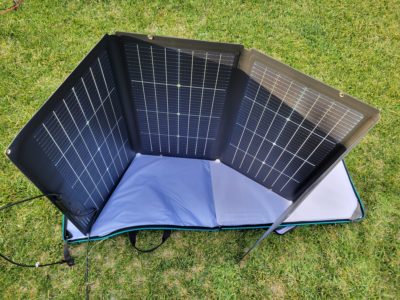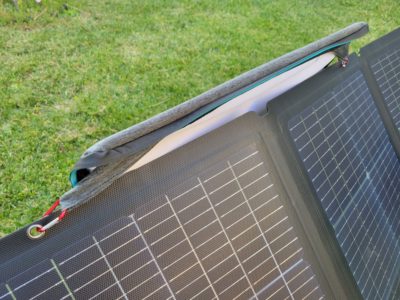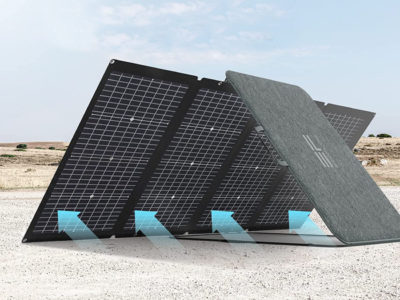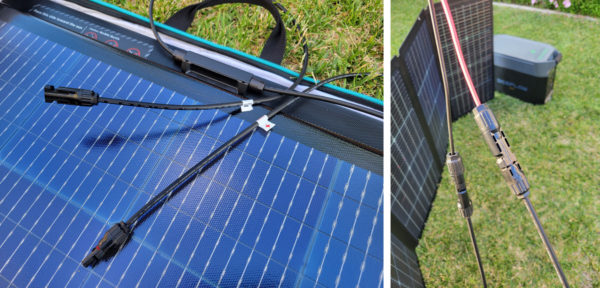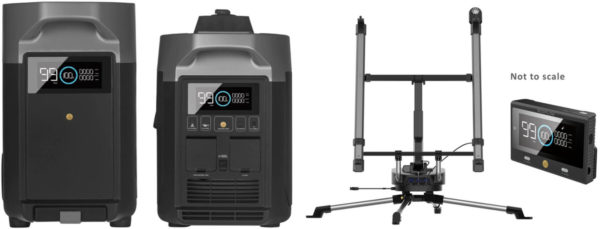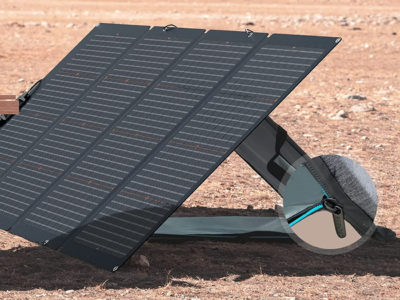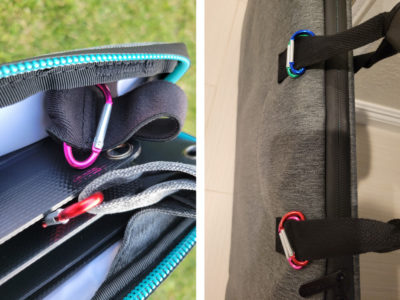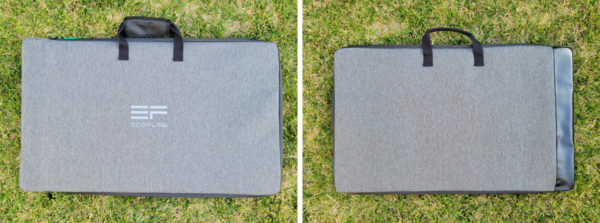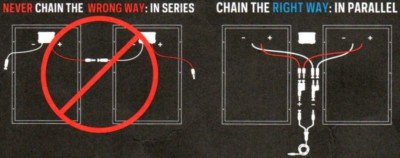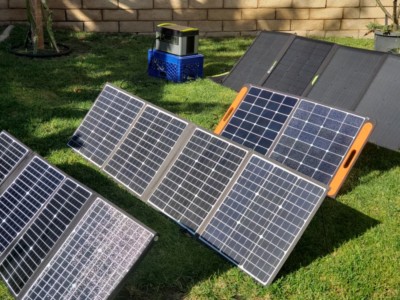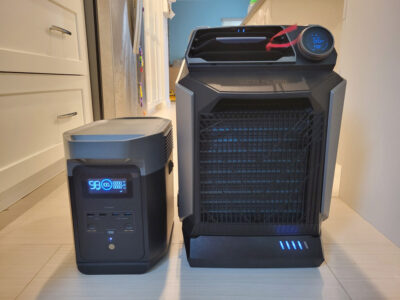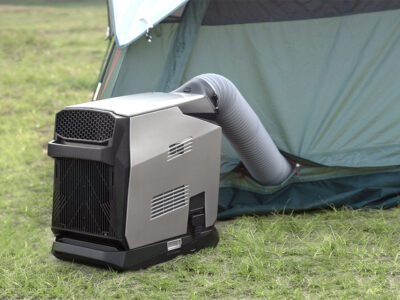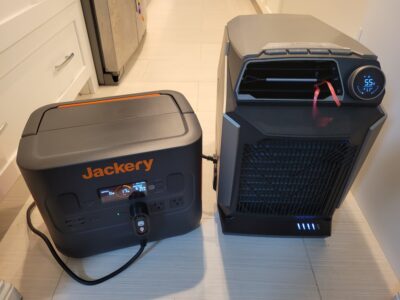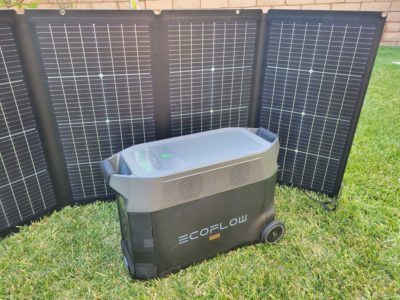EF EcoFlow 220W Bifacial Solar Panel
Contents
Dual-Sided Solar Panels
Over a year ago, I purchased the Goal Zero Nomad 200 for its large-capacity, four-pane solar panel that folded down to a 1/4 of its full size. That made it relatively compact, though at 22 lbs it was not exactly lightweight. Where it stood out was its 200W of monocrystalline charging capacity, and when used in combination with other Nomads (or the company’s more rigid Boulder panels), quite a large amount of electricity could be produced to quickly charge a battery power station with, such as the Goal Zero Yeti 1500x that can take a whopping 600W!
I had been a fan of Goal Zero’s products for a few years now, but recently, one of my good boondocking friends asked me to take a look at the EcoFlow Delta Pro power station for our mountain vacation home. That monster was so packed with features, it literally left me in awe and quickly added the company to the top of my favorite power station brands alongside Goal Zero and Jackery. Fast-forward two months later, and I thought to also take a look at something interesting: “Bifacial solar panels“. What the heck are they?
Bifacial vs Monofacial
Up until recently, all of the solar panels I had tested were monofacial — that is, only ONE face captured the sun’s energy while the other side did not. Bifacial covers a panel with cells on BOTH faces (front and back) to maximize solar energy production AND use up less space However, they tend to cost more than the 1-sided products. Imagine my surprise when EcoFlow’s 220W Bifacial Solar Panel only costed $50 more than Goal Zero’s monofacial Nomad 200… So, how did both compare?
Bifacial has solar cells covering both sides of a panel to maximize direct and indirect energy capture.
In A Nutshell
EcoFlow’s 220W Bifacial Solar Panel amazed me in a number of ways. According to the marketing material, the front-facing side could produce up to 220W of energy and the back up to 155W for a total of 375W. Reality was nowhere close to that: the most I was able to capture in testing was 198W on a bright, sunny, California day on white-painted surfaces and a MPPT controller-equipped Goal Zero Yeti 1500x. The EcoFlow Delta Pro only reached 184W a few minutes prior. Are those numbers good? Yes, absolutely!
Monocrystalline solar panels generally lose about 20-25% of efficiency from their stated rating due to loss from solar conversion. The EcoFlow 220W’s front face would, therefore, produce only up to 176W on a perfect, sunny day. Yet, my tests captured as much as 198W — where did that extra 22W come from? Its 155W backside through sunlight reflected by the ground and surrounding area. The back face actually captured roughly 14% of its capacity! Moving the panel to my grassy backyard, however, did not add much: a mere 5W-10W.
Was the small increase worth it? That depends. Any additional amount of power can make a difference in certain situations and living arrangements, especially when one was in the middle of nowhere. Whether that augmentation is worth any extra cost, however, is not black and white. The question ultimately comes down to how much the back side could consistently add to the total output, and that, my friend, depends on the surface and surrounding area.
Caution: Never leave a power station out in the sun while charging! Keep it shaded to minimize the risk of overheating AND use a long cable to connect it to the solar panel.
The more sunlight is reflected, the more the backside of bifacial solar panels can capture, though it could never reach the 75-80% efficiency the front face would. A dark, non-reflective area would hardly give any extra watts, but a mirrored room would produce a lot more — especially one that had concave reflectors aimed squarely at the back panels without burning a hole through them. A 22W increase required me to place the panels on and in an area covered in bright white to maximize the amount of reflected sunlight. That kind of exposure is not something I normally come across in my travels like campgrounds or forests. Even rocky places like Yosemite National Park that is dominated by granite would not provide that reflective power unless the panels were deployed on snow. Alas, if there was snow, the sun would not be as strong as in the summer, but that is precisely where bifacial solar panels could make a small amount of difference.
Power aside, the EcoFlow 220W costs nearly the same as the Goal Zero Nomad 200W, but has that additional 155W backside panel thrown in. That makes the EcoFlow a better deal purely from the amount of potential power produced. It also weighs about 1 lb less for nearly the same, overall dimensions.
Where the EcoFlow stands out is its IP68 water rating that allows it to be submerged in 5′ (1.5m) of freshwater for up to 30 minutes. That means that water could be spilled on it without any damage. It could theoretically also be used in rain, but that idea sounds absolutely ridiculous: does the sun shine strong enough, if at all, in that kind of weather to make any difference? Still, not many consumer manufacturers offer IP68 waterproofing.
Both the Goal Zero Nomad 200 and the EcoFlow 220W are coated with tempered glass for better protection against the elements, but the latter uses the MC4 solar cable type connection. I much prefer the Anderson Power Pole (APP) port over MC4 for its ease-of-use, but do not fret: there are adapter cables available that convert between both types, such as the iGreely MC4-to-APP from one of my favorite, lower-cost brands. What this also means is that the EcoFlow solar panel CAN be used with other manufacturers’ power stations, including Jackery, Goal Zero, and Bluetti. Check their manuals for maximum input specifications.
Caution: You should almost NEVER connect multiple solar panels to a battery in series. I generally recommend having them plugged in parallel.
A kickstand was built into the Goal Zero solar panel, but the EcoFlow took considerably longer to set up: it is held up by its own, separated carry bag and is best secured with 2 or 4 carabiners (not included). I am not a fan of that design as it felt less secure. Both allowed the panels to be angled at an optimal 45 degrees towards the sun, but neither of them could withstand strong gusts of winds without securing them down.
Multiple grommet holes could be found around the edges of both manufacturers’ solar panels to accommodate a variety of mounting configurations like off the side of a truck or on rope.
Overall, the ability to get up to an actual 198W of solar charging from a single product made the EcoFlow panel portable and convenient, though its 21lb weight could feel a bit heavy to lug around. It took about the same space as a 100W Jackery SolarSaga 100 and the Goal Zero Nomad 200. For charging a high-capacity battery like the EcoFlow Delta Pro (3,600Wh) or Goal Zero Yeti 1500x, however, the EcoFlow 220W Bifacial Solar Panel is an absolute must if you want to maximize its input capability.
What’s Good? What’s Bad?
Pros
- Bifacial panels to allow 5-25% additional energy production
- Monocrystalline solar panels provide VERY efficient charging at a consumer-friendly price point
- Most panels should expect between 70-80% charging of the stated wattage in near-perfect, sunny conditions
- Monocrystalline generally has a lifespan of 25-30 years, after which efficiency starts to drop
- Large-capacity solar charging of 220W (plus up to 40W extra from the backpanels) in a single product negates the need to bring two 100W solar panels
- Can provide higher maximum charging output to compatible battery power stations
- Example: GZ Yeti 1500x power station can take 4 solar panels with a HPP-to-HPP 4x Combiner Cable
- Keeping in mind that there is a roughly 20% solar conversion efficiency loss and that power stations can accept a limited number of panels:
- (4) 200W panels = 640W (4 x 200W – 20%). Provides full 600W power to Yeti 1500x
- (4) 100W panels = 320W (4 x 100W – 20%). Does not maximize Yeti 1500x’s charging capability
- Keeping in mind that there is a roughly 20% solar conversion efficiency loss and that power stations can accept a limited number of panels:
- Example: GZ Yeti 1500x power station can take 4 solar panels with a HPP-to-HPP 4x Combiner Cable
- Saves on storage space to have a single product instead of two
- Faster to set up and put away than with multiple solar panels
- Can provide higher maximum charging output to compatible battery power stations
- Foldable design makes the panel portable/compact, easy to stow, and protected from dust
Rigid, briefcase-style solar panels (like the Goal Zero Boulder 200) tend to be housed within an aluminum frame, have tempered glass protection, and are bulky. That makes them suitable for permanent/temporary installations (like on RV or home) and cost less than the foldable ones like this EcoFlow 220W Bifacial.
- Excellent pricing and value
- Costs slightly more than two Jackery SolarSaga 100 (to get 200W) or Goal Zero Nomad 200
- Kickstand (via its separate carry bag) to help prop the panels towards the sun at a 45 degree angle for optimal exposure
- Use 2 or 4 carabiners (not included) to secure bag to the panels
- Multiple grommet loops around the edges accommodate a variety of mounting configurations
- Side of truck, along a rope, etc.
- IP68 waterproof rating for brief, 30-minute submersion in up to 5′ of freshwater or rain
- Tempered glass layering makes solar panels stronger
- Can be used with EcoFlow’s Solar Tracker for maximum sun exposure
- Weight: 21 lbs
- Lighter than Goal Zero’s Boulder 200 (42 lbs) panels, but similar to the Nomad 200 (22 lbs)
- Heavier than TWO (to get 200W) Jackery SolarSaga 100 (5.5 lbs each)
- Daisy-chainable
- Multiple solar panels can be linked together in PARALLEL (NOT in a SERIES) for even more output (See TIPS section)
Cons
- Back side of panels heavily depend on the amount of sunlight REFLECTED by the surrounding area to be useful
- A dark, non-reflective surface or environment will hardly add any extra power, for example
- Sometimes frustrating to set up on sand (ie. beach)
- Common issue with foldable solar panels
- Kickstand is not built in and is instead formed from its carry case
- Strongly recommended to use 2 or 4 carabiners (not included) to hold in place
- No convenient way to store carabiners. Leave them attached to the grommet, and they could potentially scratch or damage the panels when stored inside the carry bag
- Potentially a single point of failure
- Example: One 220W vs two 100W panels
- If the 220W fails, you are left with no solar charging. If one of the 100W fails, you still have the second to charge with
- Example: One 220W vs two 100W panels
- Weight: 21 lbs
- Heavier than 2 Jackery SolarSaga 100 (5.5 lbs each) for the similar 200W output
- Flexible body can potentially cause the panels to snap and break
- More expensive than:
- Lesser known brands, such as Rockpals/Paxcess and Suaoki
- Non-foldable, rigid panels like Goal Zero Boulder 200 and Renogy
- No built-in USB-C or USB-C PD (Power Delivery) charging port, but that is also what makes the panels IP68 waterproof
- No built-in battery to store some of the charge generated by the panel
Tips/Notes
- Panel lifespan: Panels generally die/become inefficient between 25-30 years
- They may last longer, but would produce less energy
- Solar panels work best outdoor under full sun exposure
- Although the panels will work under the shade or behind windows, charging efficiency is greatly diminished
- That is ESPECIALLY true for the backside of bifacial solar panels
- Panels will STILL charge under cloudy conditions. So, keep the panels out even if you do not see the sun
- Operating temperature range: 14F to 149F (-10C to 65C)
- ONLY the solar panels can (and should) be directly under the sun while charging a battery power station
- Keep the power station in the shade to prevent overheating
- Although the panels will work under the shade or behind windows, charging efficiency is greatly diminished
- ALL panels must be uncovered to generate a charge
- Do not completely cover one or more panels or the charging will stop
- To maintain solar efficiency, the panels should be kept clean
- Remove dust with a soft brush and wipe with a damp (NOT wet) cloth
- Any residue, such as tree sap, should be removed as soon as possible
- Do not submerge the panel under water even though it is capable of doing so for up to 30 minutes in 5′ of depth
- Panels will work longer if they are kept away from water altogether
- Do NOT bend the panels more than 30 degrees or risk breaking them!
- Keep the panels away from fire and heaters
Solar Panel – Warning
Some power stations can be charged with one or more solar panels. There are SOME PRECAUTIONS you must take to minimize battery damage and/or injury to life/property:
- Never exceed the maximum Voltage (V) or Amperage (A) of a power station’s charging port
- If you want to use 2+ solar panels to charge faster:
- Do not mix them with different V or A as the output might get reduced (less energy generated)
- Do not daisy-chain them in sequence/series as that can exceed the power station’s maximum V or A
- Almost always connect them in PARALLEL with a Y-branch or Combiner cable
Calculations
The below calculations are rough ESTIMATES as conditions, battery and solar panel quality, and age can vary.
Battery storage capacity is measured in Wh (Watt-hours) and power output is in W (Watts).
Charge Time with Solar
- Calc: Hours to charge battery = Battery capacity (Wh) / (Panel Wattage x [0.5 or 0.75])
- In a perfect lab environment, solar panels charge at the listed wattage
- Expect to only receive 50-75% on a good, sunny day (ie. 75W – 113W for a 150W panel), depending on panel’s age, component quality, and weather
- 200W solar panel
- EcoFlow Delta Pro: As fast as 13.5 hours [3600Wh / 200W x 0.75)]
- Goal Zero Yeti 1500x: As fast as 10.1 hours [1516 Wh / (200W x 0.75)]
- Goal Zero Yeti 500x: As fast as 3.4 hours [505 Wh / (200W x 0.75)]
- Jackery Explorer 1000: As fast as 6.7 hours [1000 Wh / (200W x 0.75)]
- Tips
- Keep charging even when overcast as the panels will STILL collect energy
- Underproduction: If a 200W panel is not making enough (ie. only 50W) due to bad conditions, adding extra ones (ie. two more 200W) can generate a higher, combined output (ie. 50W + 110W from the two panels = 160W total)
- Overproduction: If the panels make more (ie. 400W) than the maximum the power station charge port can take (ie. 120W), only the max (ie. 120W) will go through
- WARNING: do NOT connect panels sequentially or you may output too much voltage and fry the power station! Almost always connect them in PARALLEL with a Y-Branch cable
Watts Used/Produced
- Calc: Watts used or produced by device = Voltage x Amperage
- Vacuum with 120V @ 9.5A uses 1,140W
- Solar panel with 12V @ 10A can produce up to 120W
Time to Charge Device
- Calc: Hours to charge device = Device’s battery capacity (Wh) / Input Wattage
- Laptop with 200Wh battery, 200W solar panel, and 75% solar conversion loss: As fast as 1.4 hrs [200 Wh / (200W x 0.75)]
Use With Other Brands
The EcoFlow 220W solar panel can be used with other manufacturers’ power stations, including Jackery, Goal Zero, and Bluetti, as long as their rated input are not exceeded, and the appropriate adapter cable is used (ie. MC4-to-APP or MC4-to-8mm).
Different Solar Panels
As long as the solar panels from different brands or wattage produce the same VOLTAGE, you will be able to safely use them together. The key here is to connect them in PARALLEL. If the panels are NOT the same voltage, then the panel with the highest volts will be used. For example, I was able to connect these four panels with the Goal Zero Yeti 1500x:
- Goal Zero Nomad 200 / Jackery SolarSaga 100W / Paxcess Rockman 120W / Suaoki 160W
- 63W = Nomad only
- 212W = Nomad + SolarSaga
- 231W = Nomad + SolarSaga + Rockman
- 262W = Nomad + SolarSaga + Rockman + Suaoki
I expected the panels to produce significantly more during the summer (to as much as 430W combined), though I never repeated the test.
Portable Air Conditioner
The EcoFlow Wave is a portable air conditioner that accepts both AC and DC input. The company, of course, recommends using its own Delta power stations for better efficiency and longer runtime because they can draw directly from DC power. In a pinch, any battery or generator capable of providing the Wave-required input wattage could be used, but keep in mind that AC power loses some energy due to conversion to DC.
Final Thoughts
The EcoFlow 220W Bifacial Solar Panel sparked my curiosity on how much better output a second set of panels built into a single product could provide. It did not wow me and required a specific, reflection-optimized environment to add any meaningful energy to the primary, front-facing panels. However, I still came away impressed because it had the potential to increase solar output for nearly the same price as Goal Zero’s Nomad 200 or two Jackery SolarSaga 100.
Higher-capacity solar panels like this EcoFlow are essential to charging large power stations (like the EcoFlow Delta Pro or Max, Goal Zero Yeti 1500x, or Jackery Explorer 1000), especially if those batteries only accept a limited number of connected panels. The foldable design allows it to be set up and put away quickly and uses up a much smaller amount of space than rigid panels that are meant to be permanently mounted. However, it also makes it more susceptible to damage if the panels are bent at an angle of more than 30 degrees.
Overall, I was very impressed by the solar charging efficiency the EcoFlow 220W provided to both the EcoFlow Delta Pro and Goal Zero Yeti 1500x batteries. The panel’s 155W backside — when deployed in an ideal environment — is a welcome icing on the cake to provide just a little extra charging juice for the traveler or home prepper.
Where To Buy
- EcoFlow
- Solar Panels: 220W “Bifacial” / 400W / Other panels
- Delta Power Stations: Pro – See our Review / Max / Mini
- Solar Panel Cables
- MC4 Extension (EcoFlow | Renogy) / EcoFlow MC4 Parallel Split / iGreely MC4-to-APP / MC4-to-XT60
- Goal Zero
- Jackery
Related Posts
- Solar Panels
- Goal Zero Nomad 200 / Jackery SolarSaga 100W / Rockpals 80W
- Power Stations
- EcoFlow Delta Pro LiFePO4
- Comparison: Goal Zero Yeti 1000 (Core, X, Lithium) vs Jackery Explorer 1000
- Goal Zero Yeti 1500x / Yeti 1000x / Yeti 500x
- Jackery Explorer 2000 Pro / Explorer 1000 / Explorer 300
- BigBlue Cellpowa500 LiFePO4
- EcoFlow Wave Portable Air Conditioner
- Quick Look
- Announcements

